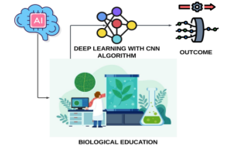Research on the Optimization of Biological Education Model in the Environment of Artificial Intelligence
Keywords:
Artificial intelligence, Biological education, CNN, OptimizationAbstract
The recent technological growth has opened the doors for incorporating new-age technology such as artificial intelligence in every field. Biological Education is a system for training biologists to work in natural science research facilities and as educators in biological fields of study. Educational optimization is a technique for making something as flawless, functional, and effective as possible. This paper presents the design and implementation of a Convolution Neural Network (CNN) for the Optimization of the Biological Education Model in the AI environment. The study proved that the suggested model has provided an efficiency of 92%.
Downloads
References
W. S. Shin and D. H. Shin, “A study on the application of artificial intelligence in elementary science education,” Elem. Sci. Educ., vol. 39, no. 1, pp. 117–132, 2020.
S. Russell and J. Bohannon, “Artificial intelligence. Fears of an AI pioneer,” Science, vol. 349, no. 6245, p. 252, 2015.
W. Shin, “Development of energy club program in connection with the curriculum of the 5th and 6th graders in the 2015 revision of elementary school,” Energy Clim. Change Educ., vol. 9, no. 2, pp. 149–159, 2019.
W. Shin, “Exploring the possibility of artificial intelligence science convergence education in energy and life unit,” Energy Clim. Change Educ., vol. 10, no. 1, pp. 73–86, 2020.
W. S. Shin and D. H. Shin, “The development of intervention program for enhancing elementary sciencepoor students’ basic science process skills. - Focus on eye movement analysis,” J. Korean Assoc. Sci. Educ., vol. 34, no. 8, pp. 795–806, 2014.
A. Abd-Alrazaq, M. Alajlani, D. Alhuwail, J. Schneider, S. AlKuwari, Z. Shah, M. Hamdi, and M. Househ, “Artificial intelligence in the right against covid-19: Scoping review,” J Med Internet Res, vol. 22, no. 12, p. e20756, 2020.
I. Ahmad, M. U. Akhtar, S. Noor, and A. Shahnaz, “Missing link prediction using common neighbor and centrality based parameterized algorithm,” Sci. Rep, vol. 10, pp. 1–9, 2020.
S. Agrebi and A. Larbi, “Use of artificial intelligence in infectious diseases,” in Artificial Intelligence in Precision Health. Academic Press, pp. 415–438, 2020.
M. A. Al-Garadi, M. S. Khan, K. D. Varathan, G. Mujtaba, A. M. Al-Kabsi, “Using online social networks to track a pandemic: a systematic review,” J Biomed Inform, vol. 62, pp. 1–11, 2016.
M. Alber, A. B. Tepole, W. R. Cannon, S. De, S. Dura-Bernal, K. Garikipati, G. Karniadakis, W. W. Lytton, P. Perdikaris, and L. Petzold et al., “Integrating machine learning and multiscale modeling—perspectives, challenges, and opportunities in the biological, biomedical, and behavioral sciences,” NPJ. Digit. Med., vol. 2, pp. 1–11, 2019.
S. R. Kellert, D. J. Case, D. Escher, D. J. Witter, J. Mikels-Carrasco, P. T. Seng, The nature of Americans. disconnection and recommendations for reconnection (National report), 2017.
L. Geng, J. Xu, L. Ye, W. Zhou, K. Zhou, “Connections with nature and environmental behaviors,” PLoS ONE, vol. 10, no. 5, p. e0127247, 2015, pmid:25985075.
G. L. Schmitz, J. B. T. Da Rocha, “Environmental education program as a tool to improve children’s environmental attitudes and knowledge,” Education, vol. 8, no. 2, pp. 15–20, 2018.
T. Braun, P. Dierkes, “Connecting students to nature–how intensity of nature experience and student age influence the success of outdoor education programs,” Environ. Educ. Res, vol. 23, no. 7, pp. 937–949, 2017.
M. W. Kleespies, J. Gübert, A. Popp, N. Hartmann, C. Dietz, and T. Spengler et al., “Connecting high school students with nature—How different guided tours in the zoo influence the success of extracurricular educational programs,” Front Psychol., vol. 11, p. 1804, 2020. pmid:32849066.
D. Šorytė and V. Pakalniškienė, “Why it is important to protect the environment: reasons given by children,” Int. Res. Geogr. Environ. Educ.,vol. 28, no. 3,pp. 228–241, 2019.
A. Yanguas-Gil, A. Mane, J. W. Elam, F. Wang, W. Severa, A. R. Daram, D. Kudithipudi, “The insect brain as a model system for low power electronics and edge processing applications,” in Proceedings of the 2019 IEEE Space Computing Conference (SCC). Pasadena, CA: IEEE, pp. 60–66, 2019.
A. Yu, K. Kumbier, “Artificial intelligence and statistics,” Front Inf. Technol. Elect. Eng., vol. 19pp. 6–9, 2018.

Downloads
Published
How to Cite
Issue
Section
License
Copyright (c) 2022 Feijia Ding, Nor Asniza Ishak

This work is licensed under a Creative Commons Attribution-ShareAlike 4.0 International License.
All papers should be submitted electronically. All submitted manuscripts must be original work that is not under submission at another journal or under consideration for publication in another form, such as a monograph or chapter of a book. Authors of submitted papers are obligated not to submit their paper for publication elsewhere until an editorial decision is rendered on their submission. Further, authors of accepted papers are prohibited from publishing the results in other publications that appear before the paper is published in the Journal unless they receive approval for doing so from the Editor-In-Chief.
IJISAE open access articles are licensed under a Creative Commons Attribution-ShareAlike 4.0 International License. This license lets the audience to give appropriate credit, provide a link to the license, and indicate if changes were made and if they remix, transform, or build upon the material, they must distribute contributions under the same license as the original.





